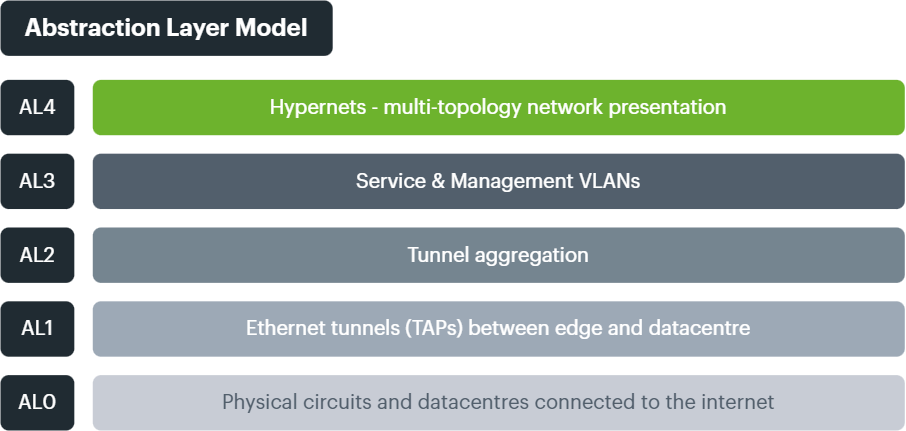Creating hypernets
What is a hypernet?#
A hypernetwork, or hypernet for short, is the network that sit on top of all the component parts that is used and interacted with by its users and systems.
Decoupled from the rigidity of physical networks and cables, a hypernet is abstracted and built entirely using our INF software.
Hypernets exist in AL4 in the Abstraction Layer model
Overlay concept#
The network fabric overlay concept breaks the relationship between the networks you want to operate (the virtual) at AL3 and the circuits and ISPs (the physical) at AL0.
The network hypervisor is used to create customised and bespoke hypernets and provide you with the power to easily change them over time.
Multiplexing networks#
Where TAGs use inverse multiplexing to distribute packets of larger traffic flows onto smaller bandwidth component TAPs, the networks created on top of the network fabric (at AL4 in the INF conceptual model) are multiplexed, meaning multiple and varied WAN design topologies and subnets can be created on top of single logical Connections.
Breaking 1:many and many:1#
This means that with the INF you can create multiple networks on a single Link, or one network on multiple Links, or any combination in between.
The ease of software#
These abstracted networks or hypernets are created in software, so they are dynamic, flexible - not static like MPLS.
Hypernets can be created, destroyed, changed and augmented by simply reconfiguring the Intelligent Network Fabric.
Complex network topology design#
Sophisticated combinations of networks can be created and managed, each with clearly defined network presentation for each site connected via the fabric.
Here is an example of 3 physical ports delivering 4 different hypernets.
- Internet with a public IP ready for a firewall
- A port with 2 subinterfaces (tagged VLANs) delivering 2 different private network subnets
- Essentially a trunk port so the customer can span whatever VLANs they choose across the connectioon to another location


